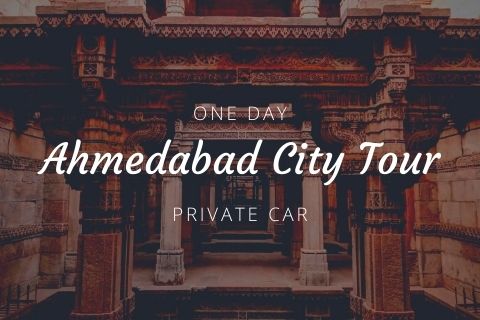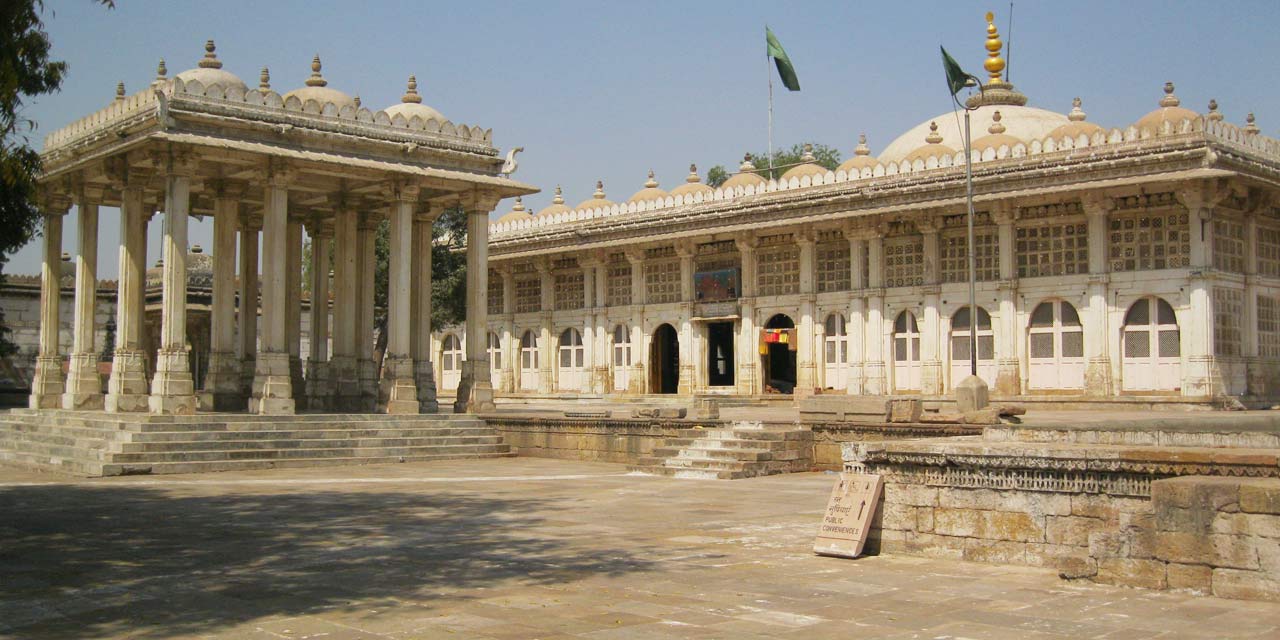Sarkhej Roza Ahmedabad Entry Fee
- No entry fee
Sarkhej Roza Ahmedabad Phone
079 2682 8675
Rating:  | 4/5 stars
| 4/5 stars
Based on total 22 reviews
Sarkhej Roza Ahmedabad Address: Post Jeevraj Park, Sarkhej Makarba Road, Makarba, Ahmedabad, Gujarat, 380051, India
Ahmedabad, the former capital city of Gujarat plays host to different communities of people from varied parts of the country. The wonderful architecture and rich culture of the city attracts several travellers.
Ahmedabad’s incredible historic monuments offer a unique experience to its visitors who throng into the city to explore its streets and heritage. Expansive derasars, impressive temples and imposing mosques reflect the heritage and history of the 600 years old city.
One of the prominent landmarks of the city, the Sarkhej Roza is known for its rich history and reverence. Though there are several rozas in the state this is the biggest of all rozas. A must-see hotspot of Ahmedabad represents the spirituality and serenity featured by most Islamic sacred places of worship.
Located 7 km South West of Ahmedabad, the sacred site is one of the striking monuments that includes a mosque, mausoleums, palace, tank and pavilions. When eminent Swiss-French architect Le Corbusier visited Sarkhej Roza, he compared it to the Acropolis of Athens.
History of Sarkhej Roza
One of the most beautiful places of worship, Sarkhej Roza draws several visitors seeking to explore its distinct architecture. An important landmark for the Muslims situated in Makarba, provides a sense of serenity to every visitor.
Hindus dominated the Sarkhej village for a long-time and were majorly involved in weaving and dying. Advisor and close friend of Sultan Ahmed Shah, Ahmed Khattu Ganj Baksh was a great sufi saint who stayed here for a long time during his last stage of his life.
He is said to have lived till his 111 years of life and died in 1445. A tomb and mosque was built by Sultan Muhammad Shah II in honour of the Saint at this place which was completed by his son Qutbuddin Ahmed Shah II in 1451 AD.
Behind the mausoleum lies the grave of a noble and general of the Akbar court, named Khwaja Ghiasuddin Ali Asaf Khan Qazwini.
During the 15th century, the historic mosque underwent expansion with the establishment of a palace and development of the Sarkhej Lake by Sultan Mahmud Begada. Other additions included pavilions and a small private mosque. Mehmud Begada named the lake after his father Sultan Ahmed Shah as Ahmed Sar and had the palaces built on its southern and western banks.
The Royal family often visited the small mosque and the holy site. Sultan Mahmud Begada also built a mausoleum for himself and his family opposite to the resting place of the saint. Adding to the charm of the place a garden was also developed.
A photographer’s delight, the revered complex has been built with the strenuous efforts of Persian brothers Azzam and Muazzam Khan. The complex also houses the mausoleums of these architects.
Architecture and the complex of Sarkhej Roza
Entering from the main gate visitors can find the Bardari that lies in the centre of the open courtyard. The elegant structure has nine domes standing with the support of sixteen pillars. It was damaged during the earthquake in 2001 and was restored by the Archaeological Survey of India.
An impressive landmark, the Sarkhej Roza is one of the finest examples of Indo-Saracenic style of architecture. More popular as the Acropolis of Ahmedabad, it houses the tombs of Saint Ahmed Khattu Ganj Baksh, King Mohammad Shah Begada and his queen.
Image Gallery of Sarkhej Roza Ahmedabad
Mausoleum of Saint Ganj Baksh also referred to as Dargah measuring to a height of 105 feet is the largest in Gujarat. Considered as an auspicious place, the dargah has a wonderful dome with a peepal leaf on its top. Dargah also holds small tombs of the saint’s disciples including the tomb of Ganj Baksh’s spiritual heir named Sheikh Salahuddin.
Mosque also called the Jama Masjid is located at a distance of 30 feet from the Dargah, spread over an area of 4300 square yards. An elegant mosque was built with a rainwater harvesting system in order to make use of rainwater during the dry season.
People would step back into time with the visit to the architectural marvel that unites Hindu, Islamic and Jain styles of architecture. An expansive complex features a combination of social, religious and royal significance.
Mausoleum of the saint and the mosque contribute to the religious world, the pavilion and the tank contribute to the social world. Royal Palaces and the tomb relate to the royal realm.
Travellers would appreciate this ancient structure that has flat roofs topped with ten domes. At the centre of the sacred complex lies the mausoleum of Saint Sheikh Ganj Bakhsh Khatu that is supported with thirteen pillars.
Mosque is encircled with corridors that connect to the prayer hall. It houses a balcony facing the tank on the southern side and has an apartment built in the shape of a loft exclusively for ladies.
It is quite different from other Islamic sacred places of worship bearing a flat roof and standing with the support of 120 pillars. History buffs would be delighted visiting the stunning historical monument that sprawls over 34 acres of land.
An interesting fact about the sacred site is that the Pesh Imam recited during the prayers echoes can be heard till the end of the sacred site. Carved pillars and elaborate lattice work adorn the Masjid which also has an open courtyard.
Palace built by Sultan Mahmud Begada lies on the southwest corner of the tank and holds a small mosque and a passage leading to Memdubad from the palace. Royal family of the king used the palace as their summer retreat. Palace was built with a pathway leading to the lake called the Haathi Khana.
Graves of the rulers Sultan Mahmud Begada, Sultan Muzaffar II and Sultan Mahmud III, the grandson of Muzaffar II lie in the King’s chamber. The graves of the wives including the tomb of the wife of Muzaffar Shah II named queen Rajabai houses an informative museum and a library.
Museum showcases the artefacts from the Sultan dynasty and the library holds the collection of books throwing the light on the history of the sacred complex.
Besides the palace one can find less popular structures that include the tombs of Ghizali Mash Hadi and Qasim Arsalan. Ghizali Mash Hadi was a renowned poet and one of the courtiers of King Akbar. Qasim Arsalan was an eminent Persian poet and calligrapher.
Entry Timings and Fees of Sarkhej Roza
People can visit Sarkhej Roza anytime between 9 am in the morning to 6 pm in the evening. Being a sacred place of worship, visitors are expected to maintain the divinity and serenity of the place and are expected to remove their footwear and cover their head with a piece of cloth before entering into the holy place.
How to Reach Sarkhej Roza
Sarkhej Roza lies 7 km Southwest of Ahmedabad in Makarba. Ahmedabad can be well accessed from various parts of the country through rail, road or air. Sardar Vallabhai Patel airport of Ahmedabad has both international and domestic flights. Buses can be taken from Gita Mandir, Kalupur railway station or Paldi.
Kalupur railway station is the nearest railway station situated at a distance of 11 km from the historic monument. Local buses, taxi or cabs can be taken from the bus stop, airport or railway station to Sarkhej Roza. For a comfortable journey, you can also book a private cab from top car rental companies in Ahmedabad and visit all the popular sightseeing places of Ahmedabad.
Nearby Attractions
ISKCON Temple, Vikram Sarabhai Space Exhibition, Adalaj Step Well and Manek Chowk
FAQ’s and General Information about Sarkhej Roza
Looking for a Ahmedabad tour package that will help you explore the city’s famous sights and experience its rich culture? Then book a Ahmedabad Darshan package with us and let us take care of everything from planning to execution. We at Ahmedabad Tourism, a division of Holidays DNA, design all-inclusive Ahmedabad tour packages that are tailored to meet the needs of every customer. So whether you want to visit the theme parks or go shopping, our expert travel planners will ensure that you don’t miss out on anything during your stay in Ahmedabad. For further information, feel free to contact us through the Contact Us form.





